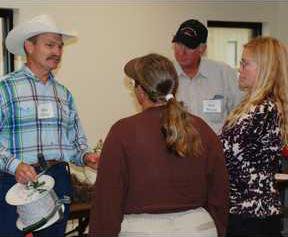The cattle business is no place to be below average. In 2009, there was a $357 per cow difference in net return between top-third Kansas producers and those in the bottom third. Higher costs were the 800-lb. gorilla in the pasture for the least profitable operations and, among those, feed expense took a King Kong-size bite out of profits.
It’s a given that grazed pasture is by far the most economical source of nutrition for cattle but how those pastures are grazed can make the difference between profit and loss.
That’s what brought producers to Lawrence, Kan., recently for a two-day Eastern Kansas Grazing School September 8-9. Sponsored by the Kansas Rural Center, the Natural Resources Conservation Service, and Kansas State University Research and Extension, the event was limited to 30 farms but there was no cap on the information presented. With an educational opportunity as intensive as the subject itself, the livestock producers explored techniques designed to give them more control over livestock demand and forage supply.
University of Missouri Extension Agricultural Economist Wesley Tucker told the participants that a management intensive grazing system can meet the nutritional needs of livestock from standing pasture while optimizing pasture yield, quality and performance. “Every day a cow is standing and you’re hauling feed to her, you’re losing money,” he said, adding that, “Cows, sheep, goats or horses can all harvest forages cheaper than you can. The biggest impact you can have on your profitability is in the area of feed cost.”
In addition to reducing the need for mechanically harvested forages, the management intensive approach can decrease or eliminate inputs like nitrogen fertilizer, herbicides and supplemental feed as well as spreading overhead costs over more animals. One of the biggest benefits of pasture subdivision, the economist pointed out, is the ability to stockpile cool season forages to reduce winter hay feeding which is the most expensive practice on most stock farms.
Management intensive grazing, Tucker explained, also allows the producer to adjust stocking rate to fit the economic situation. “When profit margins are tight,” he pointed out, “that’s when you want to maximize individual performance because each animal must cover its individual costs. When profit margins are more favorable, that’s when you want to have more animals because each animal is generating a profit.”
Tucker and several other experts from Missouri and Kansas outlined the art and science of management intensive grazing from designing multi-paddock rotational systems to forage utilization and fencing and watering advice.
Regarding fencing, Mark Green, Green County, Mo., NRCS district conservationist, said there’s no need for overkill but urged graziers not to cut corners on their chargers, insulators and ground systems. What’s most important, he said, is to keep and open mind. “There’s no monopoly on good ideas so go to field days, visit with the folks at NRCS and Extension, and talk to other cattlemen. You can always learn more.”
Kansas NRCS Rangeland Management Specialist David Kraft taught the participants how to inventory their pastures by surveying the amount of desirable plants, ground cover, residue cover, plant vigor and uniformity of use. “Be sure to watch the cattle graze and see what they select first,” he suggested. “It may not be what you expect.”
Missouri NRCS Grassland Conservationist Mark Kennedy said an intensively managed system provides grazing flexibility and allows the producer to establish goals based on the class of cattle and the quality of the forage. Through timing and stocking rate, he said, the grazier can impact animal performance.
“The more performance you want, for example, the more often you offer (the cattle) fresh forage,” he said. “You may want to allow growing animals to pick the higher quality forages and then utilize the ‘leftovers’ for dry cows with lower nutritional requirements. That’s the level of efficiency you can gain with an intensively managed system and the degree of efficiency is determined by the degree of management.”
A one-pasture continuously grazed system attains a level of about 30 percent harvest efficiency, the experts said. Intensify that to an eight-pasture system with a three to five day grazing period in each and efficiency jumps to 50 percent while 24 paddocks with one to two days grazing can up that figure to about 70 percent.
Ryan Babbitt, a Baldwin City, Kan., cattlemen, was enthusiastic about what he learned at the grazing school. “There are so many ways to be more efficient,” he said. “We tend to think that we need more acres but we can, in effect, gain more acres without buying them if we can use what we have more efficiently. This has been a great opportunity to learn how to do that.”
Jason Schmidt of the Kansas Rural Center said the Eastern Kansas Grazing School accomplished exactly what its organizers had hoped for. “We wanted to provide education geared to increased management of cool season forages,” he said. “That’s an area where we saw a need for more information and the demand was certainly there because the school filled up fast. The presenters were extremely knowledgeable and they shared an amazing amount of knowledge in two days. I think everyone was pleased with the information and we hope to do more of these in the future.”
The Kansas Rural Center is a non-profit organization dedicated to supporting and enhancing an economically viable, environmentally sound and socially sustainable agriculture through public policy and educational efforts. For more information on the Kansas Rural Center and the resources it offers farm families and their communities, log onto the Center’s web site: www.kansasruralcenter.org.
Grazing School delivers profit-enhancing lessons




